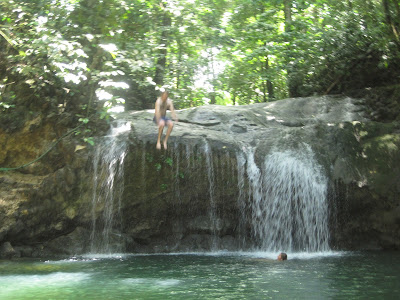Flores is the closest thing Guatemala has to Balboa Island
in Newport Beach, CA. It’s considerably smaller than Balboa Island, only taking
approximately 20 minutes to walk around the island at a slow pace. With many
fond memories from my childhood at Balboa, Flores was a great place to visit.
The main difference is that Flores is set in a large lake with fresh water
rather than a harbor with salt water.
 |
| A view from across the lake... you can see the bridge connecting Flores to the nearby town Santa Elena |
There is a walkway with a bit of a protective curb around
the entirety of the island, with a couple dozen restaurants and hotels around
the perimeter. Every restaurant boasted a happy hour (some of which spanned 24
hours long). Eventually, we landed on a place with Margaritas for 10 Quetzales
(a little more than a dollar), where we watched the sun sink in the lake.
Strangely, the temperatures after sunset don’t seem to drop a bit, which would
have been a nice relief, especially in the 107 degree heat (and humid, too!).
The hotel had a box fan but did not find it necessary to supply anything warmer
than a top sheet. Flores is a nice stop over point on the way to Tikal, which
is another 90 minute bus ride to the north, deeper into the jungle.
 |
| Sunset and Margaritas |
The next morning, after Krista jogged around the island
several times, we decided to jump in the lake for a swim. Every other day in
Guatemala has been a day for exercise, so in between times in the lake, we did
a set of push-ups on the dock and jump back in again. Afterwards, we shower off
(truly no need for hot water here because the cold water, which is actually
tepid, feels so refreshing) and get ready for breakfast.
On our way to find a breakfast spot at 9:30, we discover
that there are no buses to Tikal after 10am, so we decided there is no time for
breakfast. We check a couple of sources, and confirm that there is no bus after
10. At 9:50, I find out that the 10am bus does not run today, so I am told the
only way to get there is by a private taxi. Instead, Krista and I set off for a
30 minute walk to the neighboring town of Santa Elena where they have an actual
bus terminal. At 10:30, we buy two tickets for a bus that supposedly leaves at
12, despite what were told in Flores.
 |
| Sunrise from Flores |
We find a restaurant for a late breakfast and wait for an
hour and a half until our guy in the bus terminal directs us to a bus. We wait
another 20 minutes before taking off in the opposite direction of Tikal.
However, after 5 minutes of driving, our bus parks and waits in the main market
in Santa Elena for another 15 minutes. It’s sweltering hot in the back of the
bus, and I’m sure I’ve lost at least a liter of water by sweating so much. It’s
after 12:30, and we haven’t even left town, but once we get going again, we are
going in the general direction of Tikal. I thought the bus was full, but the
“ayudante” (or bus helper) finds twice as many people to fit into the bus, making
it all the hotter in the bus.
By the time we get to the Tikal Park Entrance (17km from the
actual ruins), we are told that we need to get out of the bus to purchase our
tickets. But what we didn’t know, was that we needed to purchase tickets for two
days, since we were entering before 3pm. The entrance fee at Tikal is more than
3 times that of any other park we’ve been to in Guatemala, and we literally do
not have enough cash to pay for two days. We intended just to go to the hotel
outside the actual ruins for the afternoon, and then explore the ruins the next
day, so we only have to pay one entrance price. Instead, the guard tells us
that if we are going in on this bus, we have to pay twice. We are left with
only one option: waiting. So we get out of the bus and wait for an hour and
half. Hopefully there will be a bus along shortly after 3, or else it’s a 17km
walk up the road to our hotel. If we set out a bit after three, we shouldn’t
have to walk to too far through the jungle in the dark.
 |
| Awaiting entrance into Tikal National Park |




























